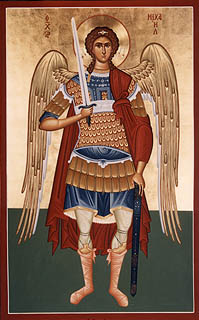Archangel Michael
Scripture and Tradition
The name Michael means "like unto God" or "Who is like unto God?"
Michael first appears in the Old Testament in the book of Joshua's account of the fall of Jericho. Though Michael is not mentioned by name in the text, it is said that Joshua "looked up and saw a man standing in front of him with a drawn sword in his hand." When the still unaware Joshua asks which side of the fight the Archangel is on, Michael responds, "neither...but as commander of the army of the Lord I have now come" (Joshua 5:13-14)1.
In the book of Daniel, Michael appears first to help the Archangel Gabriel defeat the Persians (10:13). In a later vision it is revealed to Daniel that "at that time [the end times] Michael, the great prince who protects your people, will arise. There will be a time of distress such as has not happened from the beginning of nations until then..." (Ch. 12)1. Michael thus plays an important role as the protector of Israel and later of his chosen people, the Church.
The Church Fathers also ascribe to Michael the following events: During the Exodus of the Israelites from Egypt he went before them in the form of a pillar of cloud by day and a pillar of fire by night; the power of the great Chief Commander of God was manifest in the annihilation of the 185 thousand soldiers of the Assyrian emperor Sennacherib (4/2 Kings 19:35); also in the smiting of the impious leader Heliodorus (2 Macc. 3: 24-26); and in the protection of the Three Holy Youths: Ananias, Azarias and Misail, thrown into the fiery furnace for their refusal to worship an idol (Dan 3:22-25). Through the will of God, the Chief Commander Michael transported the Prophet Habbakuk (December 2) from Judea to Babylon, to give food to Daniel in the lions' den (Dan. 14:33-37). The Archangel Michael disputed with the devil over the body of the holy Prophet Moses (Jude 1:9).
In New Testament times, the holy Archangel Michael showed his power when he miraculously saved a young man, cast into the sea by robbers with a stone about his neck on the shores of Mt Athos. This story is found in the Athonite Paterikon, and in the Life of St Neophytus of Docheiariou (November 9).
Perhaps his most famous miracle, though, is the salvation of the church at Colossae. Here a number of pagans tried to destroy this church by diverting the flow of two rivers directly into its path. However, the Archangel appeared amongst the waters, and, carrying a cross, channeled the rivers underground so that the ground the church stood on would not be destroyed. The spring which came forth after this event is said to have special healing powers.
Michael also has been associated with healing in other cases, as well as his primary role as leader of the Church Militant. He has been said to appear to Emperor Constantine the Great (d. 337) at Constantinople, to have intervened in assorted battles, and appeared, sword in hand, over the mausoleum of Hadrian, in apparent answer to the prayers of Pope St. Gregory I the Great (r. 590-604) that a plague in Rome should cease.
Russians in particular have a special veneration to Michael, along with the Theotokos. According to OCA, "Intercession for Russian cities by the Most Holy Queen of Heaven always involved Her appearances with the Heavenly Hosts, under the leadership of the Archangel Michael. Grateful Rus acclaimed the Most Pure Mother of God and the Archangel Michael in church hymns. Many monasteries, cathedrals, court and merchant churches are dedicated to the Chief Commander Michael. In Rus there was not a city where there was not a church or chapel dedicated to the Archangel Michael."
Iconography
As the Chief Commander of the Heavenly hosts, Michael usually holds a sword in one hand. In the other he often carries carries a either a shield, date-tree branch, a spear, or a white banner (possibly with a scarlet cross). He is most likely to be wearing red. In many instances, Michael tramples the devil under his feet, which may be depicted as a dragon. This comes from the tradition that Michael was the main opponent of Satan in the battle for Heaven. Satan, previously called Samael, was always looking to discredit Israel, while Michael was its main protector. In the end, Satan attempted to drag Michael down in his fall from the heights, but Michael was rescued by God.
Hymns
Troparion (Tone 4)
- O Commander of the Heavenly Hosts,
- We who are unworthy beseech you
- That by your prayers you will encompass us
- Beneath the wings of your immaterial glory
- And protect us who fall down and cry:
- Deliver us all from harm,
- For you are the commander of the powers on High.
Kontakion (Tone 2)
- Commander of the armies of God and minister of divine glory,
- Prince of the bodiless angels and guide of men:
- Ask what is good for us
- And for great mercy,
- O Supreme commander of the bodiless hosts.
Sources and Links
- Wikipedia: Archangel Michael
- OCA:Synaxis of the Archangels (search for November 8)
- GOA:Synaxis of the Archangel Michael and the other Bodiless Powers, The Miracle at Colossai (again, search for Nov. 8 for the Synaxis and Sept. 6 for Colossae)
- Prologue from Ohrid
- 1 Scripture taken from the HOLY BIBLE, NEW INTERNATIONAL VERSION®. Copyright © 1973, 1978, 1984 International Bible Society. Used by permission of Zondervan. All rights reserved.
